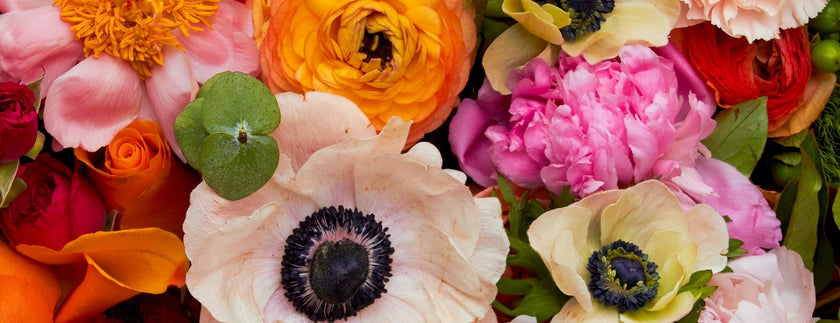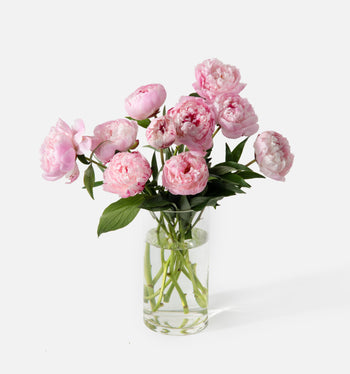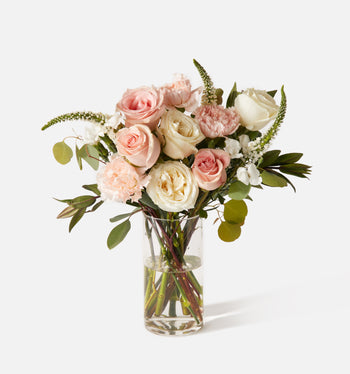The May birth flowers are lily of the valley and hawthorn. People born in May are lucky to have two birth month flowers: the enchanting lily of the valley with its heady scent and the mysterious hawthorn with all kinds of folkloric associations. Both plants produce striking flowers that bloom in May, which is why they have a special significance for those born in this month. Let’s take a look at these flowers and how they are used to symbolize and celebrate the transition from spring to summer.
May Birth Flowers
With their delicate white bell-shaped flowers and sweet scent, lily of the valley flowers are a favorite for wedding bouquets, even appearing at royal weddings. In the garden, the plants are hardy perennials that grow easily in all kinds of conditions and are used as ground cover.
Lily Name and Origins
The scientific name Convallaria majalis translates as “valley plant of May,” referring to the month when the flowers appear. These blooms are also known as May lilies and May bells (and of course, the May birth flower).
Despite the name, lilies of the valley are not actually lilies but belong to the asparagus family. However, these plants are not edible and are highly toxic to humans and animals.
The French name “muguet” is familiar to perfumers who use the scent for soaps, cologne, and sachets. Lily of the valley was Christian Dior’s favorite flower, and he used the scent as the basis for the classic perfume Diorissimo.
Lilies of the valley are native to Europe and Asia and are now widely grown around the world. In France, La Fête du Muguet is celebrated every year on May 1, when men gift bouquets of these flowers for good luck and happiness. In Serbia, the flowers are also associated with the feast of St. George and are connected with good luck and prosperity.
Symbolism and Meanings of Lily of the Valley
In the language of flowers, the meanings assigned to the lily of the valley are sweetness and humility. They are also associated with romance and feature in bridal bouquets, including those carried by Kate Middleton, Princess Diana, and Princess Grace of Monaco. Another charming meaning connected with these flowers is the return of happiness.
Lilies of the Valley are sometimes called Eve’s Tears, supposedly shed after the expulsion from Eden. They are also entwined with Christian belief and called Mary’s Tears and Our Lady’s Tears, mourning the Crucifixion.
Lily of the Valley also has a prominent place in English folklore and is associated with the celebration of spring and is worn at the Helston Floral Dance (also known as the Furry Dance).
Lily of the Valley in the Home and Garden
Lilies of the valley are a popular choice for floral bouquets and can last for six to 10 days (making them the ideal May birth flower). The stems should be cut at an angle and placed in a vase full of clean, cold water. The flowers are sensitive to heat and should be kept in a cool, shaded area away from direct sunlight. The water should be replaced every other day.
In the garden, these hardy perennials grow and propagate themselves in a variety of conditions. They can be grown from seeds or rhizomes and are often used to cover shaded and rocky areas where other plants won’t grow.
It’s important to keep in mind that all parts of the plant are toxic and should not be kept within reach of children and pets.
Hawthorn
 The pink and white flowers make a striking display in May, which is why the hawthorn has become identified as one of the May birth month flowers. Hawthorn trees have a central place in old-world mythology, especially in the Celtic world.
The pink and white flowers make a striking display in May, which is why the hawthorn has become identified as one of the May birth month flowers. Hawthorn trees have a central place in old-world mythology, especially in the Celtic world.
Hawthorn Name and Distribution
Hawthorn is a shrub that belongs to the rose family or Rosaceae, which includes many familiar flowers and fruit like apples, cherries, and pears. The name for the genus is Crataegus derived from the Greek words “kratos” (“strength”) and “akis” (“sharp”) because many species of hawthorn have sharp thorns.
The hawthorn is also known as quickthorn, thornapple, May-tree (making it the perfect May birth flower), whitethorn, quickthirn, haw berry, and Mayflower. The name of the tree is derived from the Old English word “hagathorn,” or “hedgethorn.”
This group of plants is native to northern hemisphere temperate regions in Europe, Asia, North Africa, and North America. The leaves and fruit are edible and can be used in salads and in making jellies and wine.
Symbolism and Mythology of the Hawthorn Tree
Hawthorn trees have several meanings attached to them, especially derived from European mythology and folklore. In Celtic mythology, they are linked to the fairy world, and places where hawthorn trees grow are believed to be gateways to other worlds.
In Ireland and Scotland, hawthorn trees growing near holy wells became “rag trees,” with bits of string and cloth tied to them with prayers. Hawthorn trees are associated with protection and with hope, happiness, love, and fertility.
However, bringing a hawthorn branch or flower indoors can be bad luck. Further, it is believed to be bad luck to cut down a hawthorn tree, and there is still great reluctance in Ireland to cut down one of these “fairy trees.”
Hawthorn Trees in Gardens and Fields
Hawthorn trees are planted in gardens as ornamentals for their abundant display of flowers in the spring and brightly-colored berries in the fall and winter. The berries, which start out yellow and then turn red as they ripen, provide food for birds in the winter. The thorn trees provide shelter from predators, and birds often build their nests among their branches.
The deciduous trees and shrubs can grow up to 30 feet tall. Hawthorn trees do best in full sun or partial shade and like well-drained and well-watered soil. Because of their dense structure, the shrubs were traditionally used in Europe for hedges to fence and protect livestock. They were also used as boundary markers, and the famous hedgerows of Ireland are made up of hawthorns and their relatives, the blackthorns.
May birth month flowers celebrate spring and the coming of summer and have rich meanings in culture and folklore. If you’re born in May, you’re lucky to be connected to the beauty, color, and scent of lilies of the valley and hawthorn blossoms with their meanings of sweetness, hope, and protection.
FAQs
What is the May birth flower?
The May birth flowers sare the lily of the valley and hawthorn. Lilies of the valley symbolize sweetness, humility, and happiness, while hawthorns are associated with hope, fertility, and love.
What messages does lilies and hawthorns convey?
Lilies of the valley represent purity, joy, and the promise of happiness. They are often used to celebrate love, new beginnings, or romantic connections. Hawthorns symbolize hope and protection and are often tied to themes of love, fertility, and renewal.
How can I use May birth flowers as gifts?
For birthdays, celebrate someone born in May by gifting a bouquet featuring lilies of the valley or hawthorn blossoms. For weddings or anniversaries, use these flowers to mark the moments that symbolize happiness and enduring love. Incorporate May birth flowers into floral arrangements or potted plants to add a meaningful and thoughtful element.




























